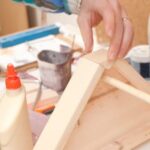What is a tenon in woodworking? Woodworking, an ancient craft, involves the use of various joinery techniques to create strong and durable woodwork. One essential joint used in woodworking is the tenon, which plays a crucial role in connecting two pieces of wood together. Understanding the basics of wood joinery, including the function of joints and their different types, is essential for mastering woodworking techniques.
Wood joinery refers to the method of joining two pieces of wood together to create different structures or woodworking projects. Joints in woodworking are critical as they determine the strength and stability of the final piece. Understanding how these joints function and their applications helps woodworkers produce high-quality work.
In this article, we will delve into the concept of tenons, exploring what they are and how they fit into the world of woodworking. We will discuss the different types of tenons used in traditional woodworking as well as modern techniques for crafting them using hand tools and power tools.
Additionally, we will highlight the importance of tenons in creating strong and durable woodwork and provide insights into their applications in various woodworking projects. By understanding the significance of tenons and learning how to work with them effectively, you can master the art of tenon joinery in your woodworking endeavors.
The Basics of Woodworking
Woodworking is a craft that involves the creation of various items using wood. One of the essential aspects of woodworking is joinery, which refers to the art of joining pieces of wood together to create a sturdy and durable structure. In woodworking, joints play a crucial role in determining the overall strength and stability of the finished product.
Understanding Joints and Their Functions
Joints in woodworking are essentially the connections between two or more pieces of wood. These connections can be formed using a variety of techniques, each with its own unique characteristics and applications. The primary functions of wood joints include providing structural support, allowing for movement or flexibility, enhancing aesthetics, and simplifying construction.
One common type of joint used in woodworking is known as a tenon. A tenon is a protruding piece on the end of a piece of wood that is designed to fit into a corresponding hole or slot (mortise) in another piece of wood.
This type of joint is known for its strength and stability, making it ideal for a wide range of woodworking projects. In addition to providing structural support, tenons also help prevent lateral movement between joined pieces, resulting in sturdier and more long-lasting constructions.
The Importance of Tenons in Creating Strong and Durable Woodwork
The use of tenons in woodworking is essential for creating strong and durable woodwork. By securely connecting two pieces of wood, tenons help distribute weight and stress evenly across the joint, preventing weak spots that could lead to structural failure over time. Additionally, when properly constructed and fitted, tenons can enhance the overall aesthetics of the finished product by creating seamless connections between wooden components.
Overall, understanding the role of tenons in woodworking is crucial for any enthusiast looking to master the craft. Whether working on traditional handcrafted projects or utilizing modern power tools, knowing how to create and utilize tenon joints effectively will significantly enhance the quality and longevity of your woodworking endeavors.
By mastering this fundamental joint technique, woodworkers can achieve greater levels of precision, strength, and creativity in their woodworking projects while ensuring long-lasting durability and stability. Working with tenon joinery opens up endless possibilities for creating furniture, structures, and decorative items that will stand the test of time.
What Is a Tenon and How Does It Fit Into Woodworking?
A tenon is a type of woodworking joint that is widely used in the craft of woodworking. It involves one piece of wood having a projection (tenon) that fits snugly into a hole on another piece of wood (mortise). The tenon and mortise joint can be seen in many different types of furniture, doors, and windows, as it provides a strong and durable connection between two pieces of wood.
The tenon is typically created by shaping the end of a piece of wood to form a protruding rectangular shape which will fit perfectly into the corresponding mortise. This creates a secure and stable joint that can withstand significant weight and pressure. Tenons can come in various shapes and sizes depending on the specific needs of the woodworking project, and they are often used in combination with other joints such as dovetails or dowels to create even stronger connections.
One key benefit of using tenons in woodworking is their ability to provide added strength to the overall structure of the finished product. By creating interlocking joinery, tenons help distribute weight more evenly across multiple points, reducing the likelihood of weak spots or potential points of failure. Additionally, because tenons are fitted together rather than relying solely on adhesives or fasteners, they can add longevity to the lifespan of wooden structures due to their inherent stability.
Exploring the Different Types of Tenons in Traditional Woodworking
In traditional woodworking, there are several different types of tenons that craftsmen use to create strong and durable joints in their woodwork. Each type of tenon has its own unique design and purpose, allowing woodworkers to choose the best option for their specific project. Let’s explore some of the most common types of tenons used in traditional woodworking.
Through Tenon
One of the most widely used types of tenons in traditional woodworking is the through tenon. This type of tenon extends all the way through the material it is joining, creating a strong and visible connection. Through tenons are often used in furniture making and timber framing due to their exceptional strength and reliability.
Stub Tenon
The stub tenon, as the name suggests, does not extend all the way through the material. Instead, it is a shorter piece that fits into a corresponding mortise on the other piece of wood. Stub tenons are commonly used in cabinet making and can be reinforced with glue or pegs for added strength.
Shoulder Tenon
Shoulder tenons have a shoulder that rests against the face of the material it is joining, providing additional support and stability. This type of tenon is often used in door and window construction, as well as in traditional joinery techniques such as dovetail joints.
Understanding the different types of tenons available in traditional woodworking allows craftsmen to carefully select the best option for their specific project, ensuring a strong and long-lasting joint. Each type has its own advantages and can be customized to fit individual design needs.
Step-by-Step Guide
Woodworking enthusiasts often pride themselves on their ability to craft intricate and durable joints using only hand tools. One such joint that requires precision and skill is the tenon. A tenon is a woodworking joint that is used to join two pieces of wood at a 90-degree angle. It consists of a protruding piece of wood (the tenon) that fits into a corresponding hole or slot (the mortise) in the other piece.
Creating a tenon using hand tools requires patience, accuracy, and attention to detail. Here is a step-by-step guide on how to create a tenon using only hand tools:
1. Measure and Mark: Begin by measuring the width of the tenon you want to create. Use a marking gauge to mark the width on all four sides of the piece of wood where the tenon will be located.
2. Remove Waste Wood: Use a backsaw to cut along the marked lines, creating shoulder cuts that define the length and depth of the tenon.
3. Shape the Tenon: Using a chisel, carefully remove the waste wood from between the shoulder cuts, creating a rectangular-shaped protrusion that fits snugly into the mortise.
4. Test Fit: Once you have removed the waste wood, test fit the tenon into its corresponding mortise. Make any necessary adjustments with your chisel until it fits securely.
5. Final Touches: Smooth out any rough edges with sandpaper or a file for a clean and polished finish.
Mastering the art of creating tenons using hand tools takes practice and precision, but it can result in beautifully crafted woodworking joints that stand the test of time.
Modern Techniques
When it comes to crafting tenons in woodworking, modern techniques using power tools have revolutionized the process, making it faster and more efficient. The use of power tools like a table saw or bandsaw can help woodworkers create precise and consistent tenons with ease. These tools allow for greater control and accuracy, resulting in stronger and more durable joints.
One of the most common power tools used to craft tenons is the table saw. With the correct setup and a dado blade, woodworkers can easily cut the cheeks of the tenon and establish the shoulder cuts. This method is especially useful for creating multiple tenons that require uniform measurements. Additionally, a bandsaw can also be used to cut the cheeks of the tenon, providing another alternative for woodworkers who prefer this tool over a table saw.
Another modern technique for crafting tenons is using a router with a straight bit or a dedicated tenoning jig. This method allows woodworkers to achieve precision and consistency when cutting both the cheeks and shoulders of the tenon. By adjusting the depth and width settings on the router, woodworkers can customize their tenons according to their specific project requirements.
Incorporating modern power tools into the process of crafting tenons has significantly streamlined the woodworking process while still maintaining the durability and strength of traditional joinery techniques.
| Tenon Crafting Method | Power Tool Used |
|---|---|
| Table Saw | Cuts cheeks and establishes shoulder cuts |
| Bandsaw | Cuts cheeks of the tenon with precision |
| Router with straight bit or dedicated jig |
The Importance of Tenons in Creating Strong and Durable Woodwork
In traditional woodworking, the joint is a crucial element when it comes to creating strong and durable woodwork. One of the most common and reliable joints used in woodworking is the tenon. What is a tenon in woodworking, you may ask? A tenon is a protruding piece of wood that is inserted into a hole or mortise to create a secure joint. It is an essential component in creating sturdy furniture, doors, frames, and other wooden structures.
The importance of tenons in creating strong and durable woodwork cannot be overstated. Here are some reasons why tenons are vital in woodworking:
- Increased Stability: Tenons provide stability to the joint, preventing the wood from shifting or moving over time.
- Enhanced Strength: When properly constructed, tenons can significantly increase the strength of the joint, making it more resistant to forces such as weight and pressure.
- Longevity: Woodwork crafted with tenon joints tends to have a longer lifespan due to the durability and stability provided by this type of joint.
Due to these factors, mastering the art of creating tenons is essential for any woodworker looking to produce high-quality and long-lasting pieces. Whether working on simple furniture or complex structural elements, understanding the significance of tenons is crucial for achieving success in woodworking projects.
Applications of Tenons in Different Woodworking Projects
Tenons are an essential element in woodworking, used to create strong and durable joints in a variety of projects. The applications of tenons in different woodworking projects are numerous, as they provide stability and support to various structures.
One common application of tenons is in the construction of furniture, where they are used to join table legs to table tops, as well as to connect chair arms to chair frames. In cabinetry, tenons play a crucial role in connecting cabinet doors and frames, providing the necessary strength and stability for everyday use.
Another important application of tenons is in the construction of doors and windows. Tenons are utilized to connect door and window frames, ensuring that they remain secure and stable over time. Additionally, tenons can be found in timber framing, where they are used to join large structural beams together, providing the necessary support for buildings such as barns, homes, and other large structures.
In addition to these applications, tenons can also be used in less traditional woodworking projects such as creating wooden toys or decorative items. In toy-making, tenons provide a sturdy connection between different parts of the toy, ensuring that it withstands the wear and tear of playtime.
Similarly, in decorative woodworking projects such as picture frames or wall art, tenons can be used to join pieces of wood together seamlessly, creating visually appealing and long-lasting pieces. Overall, the applications of tenons in woodworking projects are varied and essential for creating strong and enduring structures.
Common Mistakes and How to Avoid Them When Working With Tenons
When working with tenons in woodworking, it’s important to be mindful of common mistakes that can occur during the crafting process. One common mistake is not ensuring that the tenon and mortise fit together properly. It’s crucial for the tenon to be accurately sized to fit snugly into the corresponding mortise. If the fit is too loose, it can result in a weak joint that will not provide the necessary strength and stability for the woodwork piece.
Another common mistake when working with tenons is not properly aligning the mortise and tenon during assembly. It’s important to ensure that both pieces are perfectly aligned before gluing or securing them together. Failure to do so can result in a misaligned joint, compromising the overall integrity of the woodwork project.
Additionally, another common mistake is not adequately supporting the workpiece when using power tools to craft tenons. This can lead to accidental slips or uneven cuts, resulting in poorly shaped tenons that may not fit properly into their corresponding mortises. Using clamps or other support systems can help prevent these issues from occurring and ensure precise and accurate cuts when crafting tenons.
Overall, being aware of these common mistakes and taking proper precautions can help woodworkers avoid potential issues when working with tenons, ultimately leading to stronger, more durable wood joinery projects.
Conclusion
In conclusion, understanding the role of tenons in woodworking is crucial for anyone looking to master the art of joinery. Whether you are a beginner or a seasoned woodworker, the ability to create strong and durable joints using tenons is a valuable skill that can elevate the quality of your woodworking projects. By grasping the fundamentals of how tenons work and their different types, you can effectively apply this knowledge across various woodworking applications.
As seen throughout this article, the importance of tenons in creating enduring woodwork cannot be overstated. The structural integrity and stability they provide make them a key element in traditional woodworking techniques. Furthermore, mastering the creation of tenons using both hand tools and power tools opens up a world of possibilities for crafting intricate and bespoke wood joints. With patience, practice, and attention to detail, woodworkers can hone their skills in producing precise and well-fitted tenon joints.
In closing, the journey to mastering the art of tenon joinery in woodworking is both challenging and rewarding. By familiarizing yourself with the common mistakes to avoid when working with tenons, enhancing your skills through practical experience, and seeking inspiration from diverse woodworking projects that showcase the versatility of tenon joinery, you can expand your creative horizons as a woodworker.
Embracing the time-honored tradition of using tenons in woodworking will not only bring depth to your craft but also enable you to produce furniture pieces and structures that stand the test of time.
Frequently Asked Questions
What Does a Tenon Look Like?
A tenon in woodworking is a protruding piece of wood that is typically rectangular or cylindrical in shape. It is usually found at the end of a piece of wood and is designed to fit into a mortise.
What Is a Tenon Used for in Woodwork?
In woodwork, a tenon is used as part of a joint with a mortise to create a strong and stable connection between two pieces of wood. The tenon fits into the mortise, creating a secure bond that can withstand various forces and pressures.
What Is the Difference Between a Mortise and a Tenon?
The main difference between a mortise and a tenon lies in their shapes and how they fit together. A mortise is a cavity or hole cut into wood, while the tenon is the protruding part that fits into the mortise.
Together, they form what’s known as a “mortise and tenon joint,” which is commonly used in woodworking for its strength and durability.

Hi everyone! I’m a woodworker and blogger, and this is my woodworking blog. In my blog, I share tips and tricks for woodworkers of all skill levels, as well as project ideas that you can try yourself.





